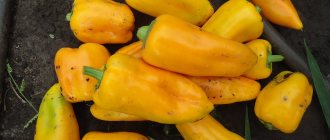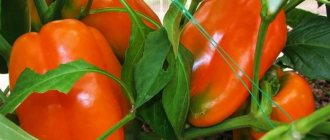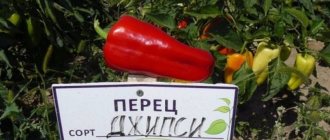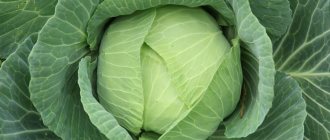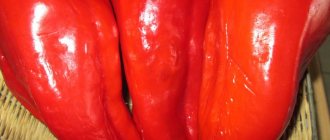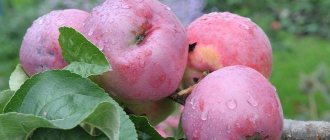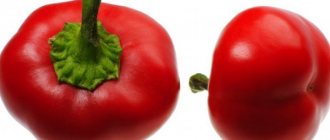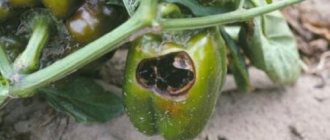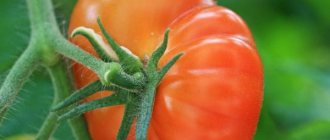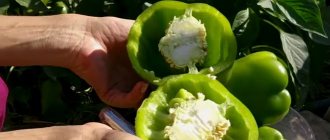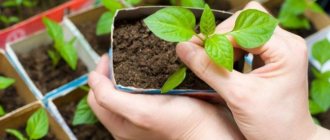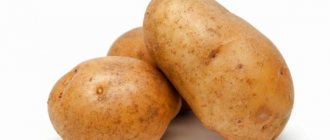One of the most popular and favorite varieties of sweet pepper is the Gift of Moldova. This culture has long won the sympathy of summer residents. The plant became widespread in the seventies of the last century and to this day is not inferior to its leading position in demand among the population. This variety has amazing qualities. Pepper Gift of Moldova has the following advantages: unpretentious disposition, excellent taste of vegetables and abundant fruiting. That is why so many summer residents give their preference to this particular variety of sweet pepper. Further in the article we will describe the main features of growing crops.
Description and characteristics of the variety
The variety was bred at the Moldavian Research Institute. For more than forty years, it began to be grown throughout Russia. Gardeners claim that the Gift of Moldova is not inferior to many hybrids bred in the modern world.
- Suitable for growing in open and closed ground.
- It has a medium early ripening period. In mid-summer, the fruits are already at the stage of technical maturity. Biological maturity occurs 125-135 days after seed germination.
- Standard type of bush. The plant is compact, low, grows up to 50 cm in height, and spreads up to 38 cm in diameter.
- It has a well-developed root system, the stem is elastic, and can easily withstand heavy loads without support.
- Many ovaries are formed and have short internodes.
- There are few leaves, they are medium in size and bright green in color.
- Productivity is high. From 1 square meter of planting you can get up to 8 kg of ripe vegetables, 1 bush produces up to 9 fruits.
- Fruiting lasts for several weeks. During the season, one bush bears fruit up to 5 times.
Important! The pepper variety Gift of Moldova does not bear fruit well in acidic soils. In such soil, in the fall, it is necessary to add lime or dolomite flour at the rate of 300-700 g per 1 sq. m. m.
- The variety is resistant to adverse weather conditions and fluctuations in humidity. To form more ovaries, it is necessary to give the plants a little more time during their flowering.
Gift of Moldova pepper: variety description
pepper Gift of Moldova
Unlike many other popular varieties, the Podarka Moldova bushes are not large in size and grow up to half a meter in height and no more than forty centimeters in diameter. The plant develops powerful roots during growth and strong stem shoots.
The bushes are formed powerful and resilient in order to be able to support a large number of vegetables until they are fully ripe. Many ovaries are formed on plants of the Gift of Moldova variety. The bushes are covered with medium-sized foliage, rich green in color.
The peppers on the plant hang down. Vegetables are distinguished by their elongated shape, reminiscent of a cone. The fruits reach ten centimeters in length. The width of the vegetables at the base is about five centimeters.
The weight of the fruit can reach one hundred grams. At an early stage of maturity, vegetables are characterized by a greenish color. Having reached full ripeness, it changes to red color. Vegetables are covered with elastic skin, under which there is juicy pulp.
The thickness of the walls of the fetus is approximately half a centimeter. The distinctive features of the variety include the taste of vegetables. These peppers are great for fresh consumption. They can be added to a salad or appetizer.
The variety of sweet pepper Podarok Moldova is used for preparing canned preparations.
Important advice for summer residents. Acidic soils are not the best suited for growing Podarok Moldova peppers. Therefore, if this is the type of soil on your site, you need to do preparatory work in advance. Lime additives will be required.
Fruit characteristics
- The fruits are smooth, cone-shaped, grow up to 10 cm in length, and the diameter at the stalk is 4-5 cm.
- The weight of the fruit is 50-100 g, most often their weight reaches 70 g.
- They have a light green color at the stage of technical ripeness; at biological maturity they become bright red.
- The skin is dense and thin.
- The pulp is juicy, reaching 5-6mm in thickness.
- It has excellent taste.
- Stores well in a cool place.
- Resistant to long-term transportation.
Advantages and disadvantages
Pepper Gift of Moldova has the following positive qualities:
- It has a beautiful and even fruit shape.
- Mid-early ripening period.
- High yield.
- Stable fruiting.
- Easy to care for.
- Resistance to adverse weather conditions.
- Stores well and can be transported over long distances.
- Has excellent taste.
- Resistant to Fusarium wilt.
The disadvantages include the following:
- Thin flesh compared to modern hybrids.
Growing seedlings
Pepper seeds “Gift of Moldova” begin to be sown for seedlings from mid to late February.
The soil. For peppers, loamy or sandy loam soil with a sufficient amount of humus, but with a minimum nitrogen content is more suitable. To grow seedlings, you can use a ready-made substrate or prepare a soil mixture yourself. To do this you will need 2 parts peat, 1 part river sand and two parts humus.
Sometimes pests and pathogenic microorganisms can enter the soil, which can subsequently harm or even destroy the seedlings. To prevent this from happening, the soil must be disinfected.
Here are a few ways to do this better:
- Freezing. The soil is wrapped in a fabric bag and taken outside for five days. After which the container with soil is brought into a warm room for a week so that parasite eggs, larvae, and bacterial spores are activated. Next, the soil is again placed in the cold. The most suitable temperature for this is -15 degrees. If it’s warm outside, the soil can be disinfected in the freezer. Repeating the procedure up to 3 times gives a good result.
- Heat treatment. Unnaturally high temperatures are also destructive for bacteria and insects. The soil can be calcined in the oven. To do this, cover the baking tray with baking paper or foil and sprinkle the soil in an even layer (5cm). In this case, the oven should be heated to 70 °C, a baking sheet with soil should be placed in the middle to ensure uniform heating for half an hour.
- Disinfection with manganese is possible two weeks before planting pepper seedlings. For 10 liters of water, 3 grams is enough. Potassium permanganate crystals. Before cultivating the soil, thoroughly mix the water with potassium permanganate until the substance is completely dissolved.
Advice. After disinfection, place the soil on a newspaper and let it sit for a while. In this way, it will be better enriched with air, which is very good for the development of the root system of plants.
Water. To water the plants, use water at room temperature. You can also melt clean snow. This water is the most beneficial for seedlings. Plantings are watered only after the top layer of soil has dried.
Light mode. To ensure that plants do not lag behind in growth and development, the duration of daylight should be at least 9-10 hours. If it is cloudy outside for more than a day, then phytolamps are installed above the plants to provide the required number of daylight hours.
Room temperature. This factor affects plant health. At low indoor temperatures, pepper seedlings may become sick and die. Optimal indicators for the growth of healthy and strong pepper seedlings in the daytime are 23–25 degrees; at night, 16 to 18 °C is acceptable.
You may be interested in:
Picking. With the growth of two permanent leaves, the plants dive into separate containers. Peppers are transplanted carefully, without damaging the root. It is important not to bury the sprouts more than 0.5 cm. The second method of picking seedlings is done during the opening of the cotyledon leaves. Unlike the first method, plants are buried down to the leaves. With this method of transplantation, it is believed that the seedlings adapt faster and begin to grow.
Hardening. When the daytime temperature reaches 15-20 °C, boxes with young plants are placed on the balcony during the day for hardening. The first time, 10-15 minutes is enough, then the time is increased by 20 minutes, gradually the seedlings can be left on the balcony for several hours. At the beginning of hardening, it is necessary to protect the plants from direct sunlight. This procedure prepares the seedlings for new open ground conditions.
If you plan to cultivate peppers in a greenhouse, seedlings are sown in February, if in open ground - at the end of March. The period for growing seedlings is about 1.5 months.
It is advisable to plant seeds immediately in separate containers. The culture is difficult to tolerate picking and any transplantation, so these procedures are performed carefully.
Seedlings are provided with sufficient sunlight - at least 14 hours a day. When the first leaves appear, the plants are fed with a mixture of:
- 3 g superphosphate;
- 1 g potassium sulfate;
- 0.5 g ammonium nitrate;
- 1 liter of water.
Water the sprouts with this solution, 100 ml for each.
After 4–8 leaves appear, the seedlings are hardened off by taking them out into the open air. Starting from 20 minutes, the time is gradually increased to 2 hours.
Peppers dive into open ground in early June, when the threat of night frosts has passed and the ground has warmed up sufficiently; to the greenhouse - in early May.
Peppers Gift of Moldova are recommended to be grown using seedlings. In order to know when it is necessary to sow pepper seeds Gift of Moldova, the gardener needs to decide how the peppers will grow, in a greenhouse or in an open area.
In the first case, the seeds must be sown in February, and in the second - in early spring. It will take about a month and a half to grow good seedlings. If the first shoots appeared at the beginning of spring, then, most likely, at the end of June the plant will delight you with ripe peppers.
Preparing soil and containers
If you are growing seedlings of Podarok Moldova peppers for the first time, then keep in mind that the emerging seedlings are actively developing in width. For this reason, containers with seedlings should not be placed too close to each other in order for the plants to develop comfortably. It is recommended to use specialized cassettes.
- The soil mixture can be purchased at a specialty store or prepared yourself. The main condition is its capacity for air and moisture.
- If the soil is clayey, it must be diluted with sand or organic matter.
- If the soil is sandy, you need to add a large amount of organic matter.
Sowing
Quite often, summer residents use seeds collected from the previous crop harvest.
- Such material requires additional preparation. It is necessary to soak the seeds for half an hour in a weak solution of potassium permanganate for disinfection.
- To stimulate seed growth, they must be soaked in water for twelve hours.
- After all the preparatory measures, the seeds must be dried and immediately sown in the ground to a depth of about two centimeters.
Care measures
Young plants must be kept in a room with a temperature of about twenty-five degrees.
- If the seeds were initially sown in a common container, they need to be planted in individual containers at the time when three leaves appear on the stems.
- Excess moisture can have a detrimental effect on seedlings, so you need to water the plant as needed.
- If you started growing seedlings at the end of winter, then you need to take care of additional lighting for the plants. For normal development, peppers need fourteen to one hour daylight hours.
- It is necessary to feed the seedlings for the first time during the formation of the first leaves. To do this, use a mixture of ammonium nitrate, potassium and superphosphate fertilizers diluted with water.
- After a couple of weeks, the feeding procedure is repeated. The volume of fertilizers used is doubled.
Formed plants must be hardened off before planting on the site. This way the crop can quickly adapt to the climatic conditions of your region. Containers with seedlings need to be transferred to the shade and then returned to sunlight.
Sweet pepper Gift of Moldova photo
By the time the seedlings need to be transplanted to a permanent place, the bushes can reach twenty centimeters in height. Transplantation is carried out in late spring or early summer based on climatic conditions.
Keep in mind that the culture is heat-loving and develops correctly only at above-zero temperatures. It is necessary to exclude the possibility of frost.
- Preparation of the site for peppers begins in the autumn. Organic and superphosphate fertilizers are applied to the soil.
- In the spring, the soil is loosened and phosphate and potassium fertilizers are applied.
- If the temperature is low enough, high beds are prepared for the pepper.
The planting scheme for peppers of the Gift of Moldova variety is half a meter by forty centimeters.
How to water a crop correctly
Peppers of the Gift of Moldova variety require regular and abundant watering. Therefore, this plant is especially good to grow in greenhouse conditions. It is extremely important to regularly water the crop during the formation of buds and the flowering period.
During the appearance of ovaries, it is also necessary to carefully ensure that the soil does not dry out and is saturated with moisture. It is recommended to water the plant in the evening. In the morning, loosen the soil.
You can also mulch the soil to retain moisture. To do this, you can use wood ash, sawdust or dry grass. These measures will also help in the fight against weed grass.
Fertilizer application
Like other varieties of peppers, bell pepper Podarok Moldova requires several feedings during growth. As practice shows, if these recommendations are followed, the crop produces an excellent harvest.
But each summer resident decides for himself what exactly to use to feed the peppers. These can be organic fertilizers or specialized complexes.
- The first feeding is carried out two weeks after planting the seedlings on the site.
- The second time the crop needs to be fed during the formation of buds.
- The third time fertilizer is applied during the period of ovary emergence.
Features of cultivation
Pepper Podarok Moldova is grown using seedlings. To cultivate the variety in greenhouses, seeds are sown in February. To plant seedlings in open ground, seed is sown in early March. In 30-45 days, the seedlings will fully strengthen and the growing season will begin in a permanent place. If sprouts appear in early March, the first fruits can be picked from the bushes at the end of June.
Important! Pepper seedlings do not tolerate picking well, so it is recommended to immediately sow the seeds in separate cups.
Seedlings of this variety quickly rise up and grow to the sides, so separate pots must be placed at a short distance from each other so that the plant has space for development. Special seedling cassettes are well suited for this.
- You can purchase ready-made soil for sowing seeds at a garden store or make it yourself.
- The soil should be loose and nutritious.
- It is recommended to add sand, humus or peat to clay soil.
- More humus is added to sandy soil.
Pepper of this variety can be grown from self-collected seeds.
- The seed material is disinfected before the procedure by dipping a weak solution of potassium permanganate for 30 minutes.
- To speed up seed germination, they are soaked in clean water for 12 hours.
- Then they are dried and immediately sown in the ground, deepening them by 1.5-2 cm.
- Strengthened sprouts should be kept in a room with an air temperature of 23-25 degrees.
- If the seeds were sown in a common container, pick them into separate cups when 2-3 true leaves appear on the seedlings.
- Water the seedlings moderately, avoiding waterlogging, otherwise the seedlings may get blackleg.
- For February sowing, it is necessary to organize additional lighting so that the seedlings receive daylight for 14 hours.
- The first feeding is carried out when a couple of true leaves appear on the plants. To do this, dilute 0.5 g of ammonium nitrate, 1 g of potassium sulfate, 3 g of superphosphate in 1 liter of water and water each plant with 100 ml.
- After 14 days, apply a second fertilizer, increasing the dosage by 2 times.
- When the seedlings have already formed 8-9 leaves, they need to be hardened off. To do this, the seedlings are alternately left in the shade, then in sunlight.
- Transplantation to a permanent place is carried out when the seedlings grow to a height of 18-20 cm. This procedure occurs in May or June, depending on weather conditions in the region.
Important! Pepper is a heat-loving plant, so even the slightest frost will kill the plant.
The place for planting peppers must be prepared in advance in the fall. The soil is dug up well and per 1 square meter of area the following is added:
- 5 kg of humus;
- 2 tbsp. spoons of superphosphate;
- 3 tbsp. spoons of wood flour.
In spring, the soil is loosened and fertilizers are scattered again:
- 1.5 tbsp. spoons of phosphate and potassium fertilizers;
- 1 tbsp. a spoonful of nitrogen fertilizers.
Attention! You should not apply fresh manure under the peppers, as due to excess nitrogen the ovaries will begin to crumble.
The seedlings are planted in a permanent place according to the pattern 50 x 40 x 30 cm, deepening them into the soil to the level of the cotyledon leaves.
Read in another article: When and how to plant pepper seedlings: planting seeds, timing rules, preparing seeds and soil, care rules
You might be interested in: Secrets of growing bell peppers in a polycarbonate greenhouse and in open ground from seeds and seedlings
How and when to plant seedlings in a permanent place
The optimal time for replanting peppers in open ground is the beginning of June, when the threat of return frosts has passed. To obtain a large pepper harvest, plants are planted in an open, sunny area with mostly light soil. Peppers “Gift of Moldova” are planted at a short distance of 40 cm from each other.
When replanting, peppers need to be buried down to the root collar. After planting, the peppers are watered with warm water and covered with agrospan or other material. This is necessary for the plants to better adapt to weather conditions.
Advice. When transplanting peppers to a permanent location, you do not need to pinch the main root. Otherwise, the plant will take a long time to be “accepted.”
In order not to destroy the seedlings, follow the rules for planting them in an open area:
- select time;
- prepare the place;
- stick to the plan.
Optimal timing
The Gift of Moldova plot is planted on May 10–20 in warm climates or in the first half of June in cool climates. During this period, the air temperature remains at 18... 19°C, the ground warms up, and there are no frosts on the ground. At this stage, the seedlings should be about 3 months old and reach 18 cm in height.
The following requirements are imposed on the place for planting the Gift of Moldova:
- good lighting;
- absence of drafts;
- protection from the north wind in the form of a wall or tall plants;
- absence of lowlands;
- lack of groundwater;
- absence of nightshades or other varieties of sweet or bitter peppers in the neighborhood;
- neutral soil composition, lightness and fertility;
- the presence of precursors in the form of legumes, onions, cabbage, radishes, zucchini, carrots;
- absence of predecessors in the form of nightshades.
Important! If pepper has already grown on the site, the next time it can be planted in this place no earlier than after 3 years.
Before winter, the beds are dug up and fertilized with humus, compost, superphosphate, and wood ash. In the spring they are dug up again, potassium, nitrogen, and phosphate fertilizers are added.
When planting seedlings, follow the following scheme:
- the depth of the holes is up to the cotyledon leaves;
- interval between rows - 40 cm;
- the interval between plants is 50 cm.
